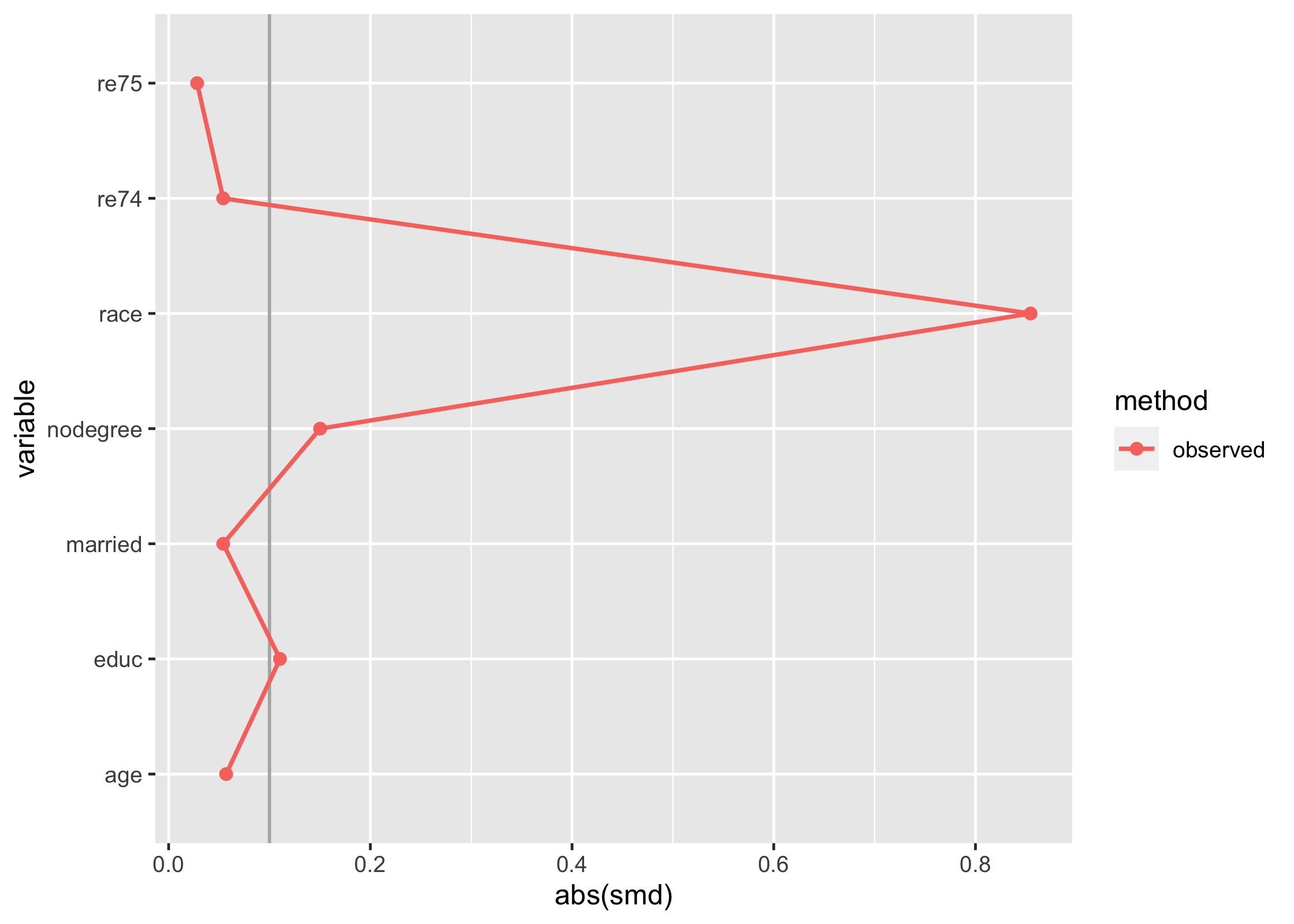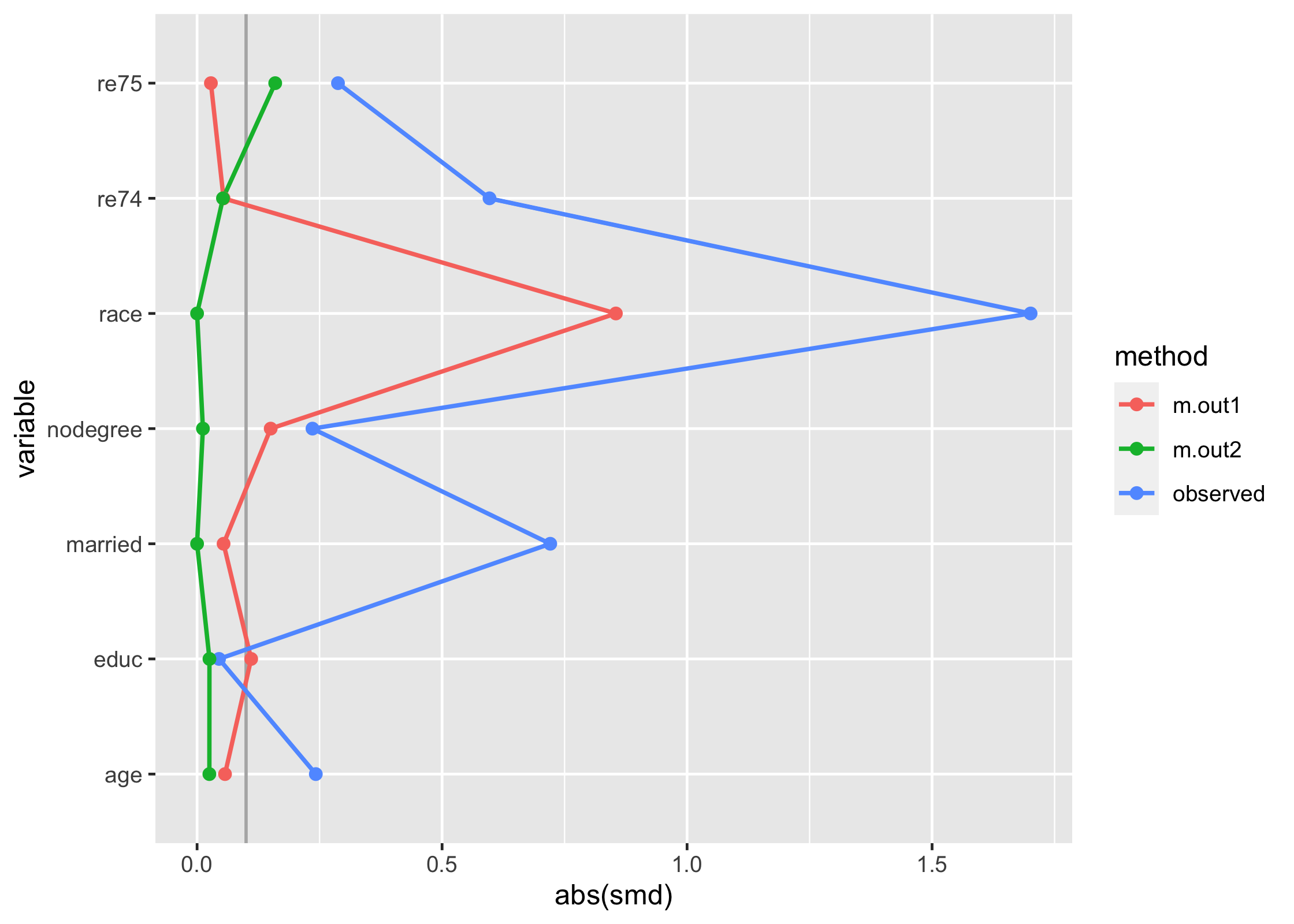The hardware and bandwidth for this mirror is donated by dogado GmbH, the Webhosting and Full Service-Cloud Provider. Check out our Wordpress Tutorial.
If you wish to report a bug, or if you are interested in having us mirror your free-software or open-source project, please feel free to contact us at mirror[@]dogado.de.
The goal of tidysmd is to easily create tidy data frames of SMDs. tidysmd wraps the smd package to easily calculate SMDs across many variables and using several weights in order to easily compare different adjustment strategies.
You can install the most recent version of tidysmd from CRAN with:
install.packages("tidysmd")Alternatively, you can install the development version of tidysmd from GitHub with:
# install.packages("devtools")
devtools::install_github("malcolmbarrett/tidysmd")tidy_smd() supports both unweighted SMDs and weighted
SMDs.
library(tidysmd)
tidy_smd(nhefs_weights, c(age, education, race), .group = qsmk)
#> # A tibble: 3 × 4
#> variable method qsmk smd
#> <chr> <chr> <chr> <dbl>
#> 1 age observed 1 -0.282
#> 2 education observed 1 0.196
#> 3 race observed 1 0.177nhefs_weights contains several types of propensity score
weights for which we can calculate SMDs. Unweighted SMDs are also
included by default.
tidy_smd(
nhefs_weights,
c(age, race, education),
.group = qsmk,
.wts = c(w_ate, w_att, w_atm)
)
#> # A tibble: 12 × 4
#> variable method qsmk smd
#> <chr> <chr> <chr> <dbl>
#> 1 age observed 1 -0.282
#> 2 race observed 1 0.177
#> 3 education observed 1 0.196
#> 4 age w_ate 1 -0.00585
#> 5 race w_ate 1 0.00664
#> 6 education w_ate 1 0.0347
#> 7 age w_att 1 -0.0120
#> 8 race w_att 1 0.00365
#> 9 education w_att 1 0.0267
#> 10 age w_atm 1 -0.00184
#> 11 race w_atm 1 0.00113
#> 12 education w_atm 1 0.00934Having SMDs in a tidy format makes it easy to work with the
estimates, for instance in creating Love plots. tidysmd includes
geom_love() to make this a bit easier:
library(ggplot2)
plot_df <- tidy_smd(
nhefs_weights,
race:active,
.group = qsmk,
.wts = starts_with("w_")
)
ggplot(
plot_df,
aes(
x = abs(smd),
y = variable,
group = method,
color = method,
fill = method
)
) +
geom_love()
You can also use the quick-plotting function
love_plot(), if you prefer:
love_plot(plot_df) +
theme_minimal(14) +
ylab(NULL)
tidysmd also has support for working with matched datasets. Consider these two objects from the MatchIt documentation:
library(MatchIt)
# Default: 1:1 NN PS matching w/o replacement
m.out1 <- matchit(treat ~ age + educ + race + nodegree +
married + re74 + re75, data = lalonde)
# 1:1 NN Mahalanobis distance matching w/ replacement and
# exact matching on married and race
m.out2 <- matchit(treat ~ age + educ + race + nodegree +
married + re74 + re75, data = lalonde,
distance = "mahalanobis", replace = TRUE,
exact = ~ married + race)One option is to just look at the matched dataset with tidysmd:
matched_data <- get_matches(m.out1)
match_smd <- tidy_smd(
matched_data,
c(age, educ, race, nodegree, married, re74, re75),
.group = treat
)
love_plot(match_smd)
The downside here is that you can’t compare multiple matching
strategies to the observed dataset; the label on the plot is also wrong.
tidysmd comes with a helper function, bind_matches(), that
creates a dataset more appropriate for this task:
matches <- bind_matches(lalonde, m.out1, m.out2)
head(matches)
#> treat age educ race married nodegree re74 re75 re78 m.out1 m.out2
#> NSW1 1 37 11 black 1 1 0 0 9930.0460 1 1
#> NSW2 1 22 9 hispan 0 1 0 0 3595.8940 1 1
#> NSW3 1 30 12 black 0 0 0 0 24909.4500 1 1
#> NSW4 1 27 11 black 0 1 0 0 7506.1460 1 1
#> NSW5 1 33 8 black 0 1 0 0 289.7899 1 1
#> NSW6 1 22 9 black 0 1 0 0 4056.4940 1 1matches includes an binary variable for each
matchit object which indicates if the row was included in
the match or not. Since downweighting to 0 is equivalent to filtering
the datasets to the matches, we can more easily compare multiple matched
datasets with .wts:
many_matched_smds <- tidy_smd(
matches,
c(age, educ, race, nodegree, married, re74, re75),
.group = treat,
.wts = c(m.out1, m.out2)
)
love_plot(many_matched_smds)
These binaries (installable software) and packages are in development.
They may not be fully stable and should be used with caution. We make no claims about them.
Health stats visible at Monitor.